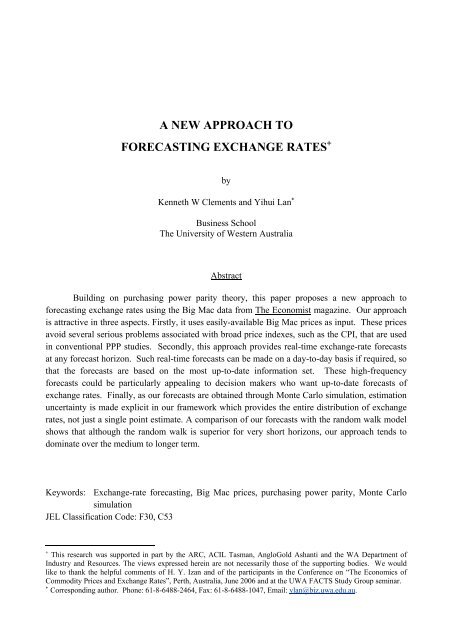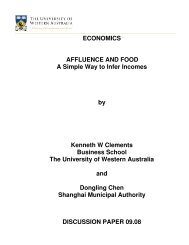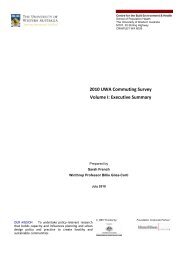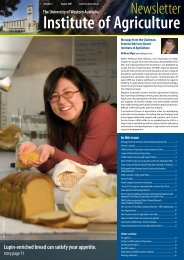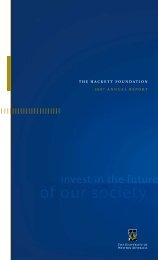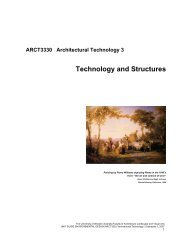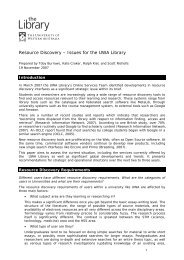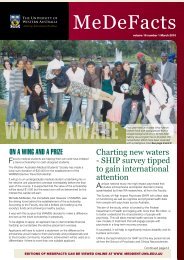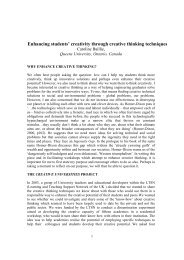a new approach to forecasting exchange rates - The University of ...
a new approach to forecasting exchange rates - The University of ...
a new approach to forecasting exchange rates - The University of ...
Create successful ePaper yourself
Turn your PDF publications into a flip-book with our unique Google optimized e-Paper software.
A NEW APPROACH TOFORECASTING EXCHANGE RATES +byKenneth W Clements and Yihui Lan ∗Business School<strong>The</strong> <strong>University</strong> <strong>of</strong> Western AustraliaAbstractBuilding on purchasing power parity theory, this paper proposes a <strong>new</strong> <strong>approach</strong> <strong>to</strong><strong>forecasting</strong> <strong>exchange</strong> <strong>rates</strong> using the Big Mac data from <strong>The</strong> Economist magazine. Our <strong>approach</strong>is attractive in three aspects. Firstly, it uses easily-available Big Mac prices as input. <strong>The</strong>se pricesavoid several serious problems associated with broad price indexes, such as the CPI, that are usedin conventional PPP studies. Secondly, this <strong>approach</strong> provides real-time <strong>exchange</strong>-rate forecastsat any forecast horizon. Such real-time forecasts can be made on a day-<strong>to</strong>-day basis if required, sothat the forecasts are based on the most up-<strong>to</strong>-date information set. <strong>The</strong>se high-frequencyforecasts could be particularly appealing <strong>to</strong> decision makers who want up-<strong>to</strong>-date forecasts <strong>of</strong><strong>exchange</strong> <strong>rates</strong>. Finally, as our forecasts are obtained through Monte Carlo simulation, estimationuncertainty is made explicit in our framework which provides the entire distribution <strong>of</strong> <strong>exchange</strong><strong>rates</strong>, not just a single point estimate. A comparison <strong>of</strong> our forecasts with the random walk modelshows that although the random walk is superior for very short horizons, our <strong>approach</strong> tends <strong>to</strong>dominate over the medium <strong>to</strong> longer term.Keywords: Exchange-rate <strong>forecasting</strong>, Big Mac prices, purchasing power parity, Monte CarlosimulationJEL Classification Code: F30, C53+ This research was supported in part by the ARC, ACIL Tasman, AngloGold Ashanti and the WA Department <strong>of</strong>Industry and Resources. <strong>The</strong> views expressed herein are not necessarily those <strong>of</strong> the supporting bodies. We wouldlike <strong>to</strong> thank the helpful comments <strong>of</strong> H. Y. Izan and <strong>of</strong> the participants in the Conference on “<strong>The</strong> Economics <strong>of</strong>Commodity Prices and Exchange Rates”, Perth, Australia, June 2006 and at the UWA FACTS Study Group seminar.∗Corresponding author. Phone: 61-8-6488-2464, Fax: 61-8-6488-1047, Email: ylan@biz.uwa.edu.au.
“Most people dealing in the foreign <strong>exchange</strong> market have no clue about the fundamental value <strong>of</strong>the dollar (the “quality” <strong>of</strong> the dollar). Specialists and pr<strong>of</strong>essors do not know either, at leastwithin a broad range <strong>of</strong> dollar-euro <strong>rates</strong> between say, $1.0 and $1.3. For every specialist tellingus that the fundamental value <strong>of</strong> the dollar is close <strong>to</strong> $1.3 <strong>to</strong> the euro there will be another oneaffirming that $1.0 is near the fundamental value. Anything in between is a fair game.”1. IntroductionPaul de Grauwe, Financial Times. Jan 13, 2006. p. 19.Since the breakdown <strong>of</strong> the Bret<strong>to</strong>n Woods system <strong>of</strong> fixed <strong>exchange</strong> <strong>rates</strong> in the early1970s, <strong>forecasting</strong> currency values has become crucial for many purposes such as internationalcomparisons <strong>of</strong> incomes, earnings and the costs <strong>of</strong> living by international agencies, managementand alignment <strong>of</strong> <strong>exchange</strong> <strong>rates</strong> by governments, and corporate financial decision making. Eventhough it is widely agreed that <strong>forecasting</strong> <strong>exchange</strong> <strong>rates</strong> is a no<strong>to</strong>riously difficult task (asindicated by de Grauwe’s comments above), there are still many attempts <strong>to</strong> do so. This paperbuilds on purchasing power parity theory and introduces a <strong>new</strong> <strong>approach</strong> <strong>to</strong> forecast <strong>exchange</strong><strong>rates</strong> based on the Big Mac data published by <strong>The</strong> Economist magazine.In the <strong>exchange</strong>-rate <strong>forecasting</strong> literature, the paper by Meese and Rog<strong>of</strong>f (1983) remains highlyinfluential as it demonst<strong>rates</strong> that structural models are unable <strong>to</strong> outperform the random walkmodel, which simply predicts that the <strong>exchange</strong> rate would not change at all. Though the randomwalk model has occupied center stage for many years, practitioners and researchers continue <strong>to</strong>employ a variety <strong>of</strong> techniques in an effort <strong>to</strong> beat the random walk. Generally speaking, there arethree distinct <strong>approach</strong>es <strong>to</strong> <strong>exchange</strong>-rate <strong>forecasting</strong>:• Surveys, which are popular among practitioners. But it is found that while survey forecastsprovide some predictive power (Lai, 1990, Chinn and Frankel, 1994a), sometimes they arebiased (Chinn and Frankel, 1994b) and unreliable (Harrison and Mogford, 2004).• Model-based <strong>approach</strong>es, which include (i) fundamentals models, (ii) linear time seriesmodels and (iii) non-linear time series models. <strong>The</strong> monetary <strong>approach</strong> is a popularfundamentals model, with explana<strong>to</strong>ry variables including relative prices levels, interest ratedifferentials, and other determinants <strong>of</strong> equilibrium in the money market. Abhyabkara et al.(2005) show that the economic value, as opposed <strong>to</strong> the statistical accuracy, <strong>of</strong> <strong>exchange</strong>-rateforecasts based on a fundamentals model, can be greater than that based on the random walkmodel. <strong>The</strong> traditionally-used linear time series models are the random walk, ARIMA, ormultivariate systems models such as the VAR model and the VECM. A recent stream <strong>of</strong>research focuses on non-linear time series models, which includes the simultaneous nearest-1
neighbour <strong>approach</strong> by Fernandez-Rodriguez et al. (1999), and the neural networks <strong>of</strong> Zhangand Hu (1998).• <strong>The</strong> composite forecast <strong>approach</strong>, which involves taking weighted averages <strong>of</strong> forecastsfrom alternative <strong>approach</strong>es. MacDonald and Marsh (1994) review the earlier literature andtheir examination <strong>of</strong> various methods <strong>of</strong> forecast combination shows that they can lead <strong>to</strong>improvements in forecast accuracy. More recent examples <strong>of</strong> composite forecasts include Qiand Wu (2003) in which neural networks and monetary fundamentals are used <strong>to</strong> model<strong>exchange</strong> <strong>rates</strong>, and Alvarez-Diaz and Alvarez (2005) who combine forecasts from two nonlinearmodels.PPP-based <strong>exchange</strong>-rate forecasts belong <strong>to</strong> the fundamentals stream <strong>of</strong> the model-based<strong>approach</strong>, and use the relative price levels in two countries in question as fundamentals. <strong>The</strong>re arethree versions <strong>of</strong> PPP: the absolute version, the relative version, and the s<strong>to</strong>chastic relative version.While the first two versions are <strong>of</strong>ten explained in textbooks, it is the third version that <strong>of</strong>particular interest <strong>to</strong> researchers. Relative PPP implies that the <strong>exchange</strong> rate and the relativeprices are exactly proportional, so that the real <strong>exchange</strong> rate (the <strong>exchange</strong> rate deflated byrelative prices) is a constant. S<strong>to</strong>chastic relative PPP, on the other hand, allows for systematicdeviations from this constant, and treats this constant as the center <strong>of</strong> gravity <strong>to</strong> which the real<strong>exchange</strong> rate reverts in the long run. Research on this weaker version <strong>of</strong> PPP examines the timeseriesproperties <strong>of</strong> <strong>exchange</strong> <strong>rates</strong>, and tests for mean reversion and the speed <strong>of</strong> adjustment <strong>to</strong>long-run equilibrium values. <strong>The</strong> estimated long-run <strong>exchange</strong> <strong>rates</strong> and the speed-<strong>of</strong>-adjustmentparameters are then used for the purpose <strong>of</strong> <strong>exchange</strong>-rate <strong>forecasting</strong>.In most studies <strong>of</strong> PPP, the real <strong>exchange</strong> rate is usually defined using the price index based on abroad basket <strong>of</strong> goods, such as the consumer price index, wholesale price index, or GDP defla<strong>to</strong>r. 1<strong>The</strong> use <strong>of</strong> broad indexes is subject <strong>to</strong> several serious problems however. First, many priceindexes are published only at infrequent intervals; in Australia, for example, the CPI is publishedonly quarterly and then with a considerable lag, which limits its usefulness for timely forecasts.Second, differences in consumption patterns in different countries mean that broad indexes relate<strong>to</strong> the prices <strong>of</strong> baskets <strong>of</strong> goods and services that can differ substantially internationally. 2 In PPPtheory the ratio <strong>of</strong> prices at home <strong>to</strong> those abroad is meant <strong>to</strong> reflect differing monetary conditionsonly, but when broad indexes are used, this ratio could be dominated by heterogeneity <strong>of</strong>1 For an analysis <strong>of</strong> the impact <strong>of</strong> using differing broad price indexes on <strong>exchange</strong>-rate forecasts, see Xu (2003).2 For example, food occupies less than 10 percent <strong>of</strong> <strong>to</strong>tal consumption in rich countries, while it absorbs somethinglike 50 percent in the poorest.2
consumption patterns. Thus, rather than comparing like with like <strong>to</strong> isolate the underlyingmonetary fac<strong>to</strong>rs, the CPI-based price ratios could be subject <strong>to</strong> substantial biases or becontaminated with measurement error. Finally, most statistical agencies construct price indexesby carrying out surveys <strong>of</strong> prices and derive the index weights from household expendituresurveys for CPIs, and use similar procedures for other types <strong>of</strong> indexes. Accordingly, theseindexes are subject <strong>to</strong> sampling error, a problem that is ignored by most PPP studies. 3 In thispaper, we largely avoid these problems by using a single-good basket -- a McDonald’s Big Machamburger.<strong>The</strong> main contributions <strong>of</strong> the paper are tw<strong>of</strong>old: (i) It develops a <strong>new</strong> <strong>approach</strong> <strong>to</strong> <strong>forecasting</strong><strong>exchange</strong> <strong>rates</strong>, based on easily-available Big Mac prices. In this <strong>approach</strong>, we model not onlyreal <strong>exchange</strong> <strong>rates</strong>, but also the evolution <strong>of</strong> Big Mac prices. 4 (ii) This <strong>new</strong> <strong>approach</strong> issufficiently flexible <strong>to</strong> be able <strong>to</strong> provide forecasts <strong>of</strong> <strong>exchange</strong> <strong>rates</strong> in real time. <strong>The</strong> real timeattraction is that the <strong>approach</strong> incorpo<strong>rates</strong> the most recent shocks in<strong>to</strong> the model, thus allowingthe forecasts <strong>to</strong> be made on the basis <strong>of</strong> a comprehensive information set. Such real-time forecastsare <strong>of</strong> practical significance for decision makers in government, the corporate world and those infinancial markets, who require up-<strong>to</strong>-date forecasts.<strong>The</strong> structure <strong>of</strong> the paper is as follows. Section 2 briefly describes the Big Mac data, whileSection 3 models these prices. In Section 4 we draw on Lan (2006) <strong>to</strong> model Big Mac real<strong>exchange</strong> <strong>rates</strong>, <strong>to</strong> estimate <strong>exchange</strong> rate equations, and <strong>to</strong> test for PPP. This leads <strong>to</strong> aconvenient way <strong>to</strong> forecast real <strong>exchange</strong> <strong>rates</strong> for any horizon, using a Monte Carlo <strong>approach</strong> <strong>to</strong>derive the whole distribution <strong>of</strong> future <strong>rates</strong>, rather than single point estimates. Section 5 thenmerges the forecasts <strong>of</strong> Big Mac prices and real <strong>exchange</strong> <strong>rates</strong> <strong>to</strong> yield forecasts <strong>of</strong> nominal<strong>exchange</strong> <strong>rates</strong>. Using the random walk model as the benchmark, in Section 6 we evaluate theperformance <strong>of</strong> our <strong>approach</strong>, and find that although the random walk is superior for short forecast3 <strong>The</strong>re is possibly a further problem with broad price indexes in that they are dominated by the prices <strong>of</strong> goods that donot enter in<strong>to</strong> international trade, such as rents, retail margins, much <strong>of</strong> medical care, utility services, etc. For theprices <strong>of</strong> such nontraded goods, it is far from clear exactly how they are related (if at all) <strong>to</strong> the <strong>exchange</strong> rate. Whileit cannot be claimed that the use <strong>of</strong> Big Mac prices completely avoids this problem, the traded component <strong>of</strong> a BigMac is likely <strong>to</strong> be larger than that <strong>of</strong> the basket underlying the CPI for instance.4 A previous Burgernomics <strong>approach</strong> <strong>to</strong> <strong>forecasting</strong> <strong>exchange</strong> <strong>rates</strong> <strong>to</strong>ok the forecast <strong>of</strong> Big Mac prices as being the insamplemeans, based on signal-extraction techniques (Lan, 2006). By contrast, the current paper explicitly models thetime-series dynamics <strong>of</strong> Big Mac prices. We also extend Lan (2006) by introducing the idea <strong>of</strong> real-time forecastswhereby the horizon is not restricted <strong>to</strong> be integer. For reviews <strong>of</strong> the literature on Burgernomics, see Lan (2006) andOng (2003). For reviews <strong>of</strong> the whole PPP area, see the surveys by Froot and Rog<strong>of</strong>f (1995), Lan and Ong (2003),Rog<strong>of</strong>f (1996), Sarno and Taylor (2002), Taylor and Taylor (2004), and Taylor (2006). While there is stillconsiderable controversy, it is possible <strong>to</strong> summarise current thinking as follows: As supportive evidence for PPP as along-run proposition has emerged in recent years, PPP has been resurrected as a theory <strong>of</strong> long-run <strong>exchange</strong> ratedetermination.3
horizons, the Big Mac model tends <strong>to</strong> do better over the medium <strong>to</strong> longer term. Section 7presents a refinement <strong>to</strong> the procedure by adjusting the forecasts <strong>to</strong> reflect systematic trackingerrors in the immediately preceding period. Concluding remarks are presented in the final section.2. Big Mac Real Exchange Rates<strong>The</strong> real <strong>exchange</strong> rate (RER) is conventionally defined in terms <strong>of</strong> natural logarithms asct(1) q = log P ,S Pwherect *ct tP ct is the price level in country c in terms <strong>of</strong> domestic currency in year t,corresponding price level in the US, and*P t theS ct the nominal <strong>exchange</strong> rate quoted as the domesticcurrency cost <strong>of</strong> $US1. According <strong>to</strong> PPP, a positive (negative) value <strong>of</strong> the RER q ct implies thatcountry c’s currency is overvalued (undervalued) in year t. <strong>The</strong> support for PPP comes from thestationarity <strong>of</strong> real <strong>exchange</strong> <strong>rates</strong>.Instead <strong>of</strong> using broad indices such as the CPI or WPI, this paper uses a single-good basket -- aMcDonald’s Big Mac hamburger, whose prices have been published in <strong>The</strong> Economist magazinesince 1986. 5 This “basket” includes tradable items such as buns and beef, as well as nontradableitems such as rent and wages. Though sometimes criticised as being <strong>to</strong>o “narrow”, the basket isattractive because Big Macs are produced in around 120 countries around the world using almostidentical ingredients and the previous Big Mac literature shows that it performs at least as well asother indices used in PPP studies (see, e.g., Chen et al., 2003, Cumby 1996, Ong 1997, 2003, andParsley and Wei, 2003).Table 1 presents the Big Mac prices in six major countries and the US and the correspondingnominal <strong>exchange</strong> <strong>rates</strong> from 1994 <strong>to</strong> 2006. 6Figure 1 presents the RERs q ct for c = 1,...,6countries and t = 1,...,13 years, calculated using the Big Mac prices. 7 It can be seen that there are5 In view <strong>of</strong> the substantial opportunity cost <strong>of</strong> a full page <strong>of</strong> <strong>The</strong> Economist, that the magazine continues <strong>to</strong> publishthe Big Mac article after 20 years indicates its perceived value <strong>to</strong> its readers. See Lan (2006) and Lan and Ong (2003).6 <strong>The</strong> <strong>exchange</strong> <strong>rates</strong> we consider refer <strong>to</strong> the six most important currencies. <strong>The</strong> start <strong>of</strong> the sample period, 1994, isdetermined by the earliest year when the bilateral <strong>exchange</strong> <strong>rates</strong> <strong>of</strong> the euro and its member countries are available(http://ec.europa.eu/budget/inforeuro/ index.cfm?fuseaction=dsp_html_monthly_<strong>rates</strong>&Language=en).7 <strong>The</strong> currency over/under-valuation employed by <strong>The</strong> Economist magazine is the percentage difference between thePPP <strong>exchange</strong> rateor q ct is small.ct*tP /P and the actual rate S ct ,*ct ct t ct ctr = (P /P − S )/S . Mathematically, log(1 + r ct ) ≈ qctwhen r ct4
TABLE 1BIG MAC PRICES AND NOMINAL EXCHANGE RATESYear Australia Britain Canada Euro Japan Switzerland USA. Big Mac prices (Domestic currency units)1994 2.45 1.81 2.86 2.51 391 5.70 2.301995 2.45 1.74 2.77 2.50 391 5.90 2.321996 2.50 1.79 2.86 2.53 288 5.90 2.361997 2.50 1.81 2.88 2.50 294 5.90 2.421998 2.65 1.84 2.79 2.44 280 5.90 2.561999 2.65 1.90 2.99 2.52 294 5.90 2.432000 2.59 1.90 2.85 2.56 294 5.90 2.512001 3.00 1.99 3.33 2.57 294 6.30 2.542002 3.00 1.99 3.33 2.67 262 6.30 2.492003 3.00 1.99 3.20 2.71 262 6.30 2.712004 3.25 1.88 3.19 2.74 262 6.29 2.902005 3.24 1.88 3.27 2.91 250 6.30 3.062006 3.25 1.94 3.52 2.94 250 6.30 3.10B. Nominal <strong>exchange</strong> rate (Domestic currency cost <strong>of</strong> US$1)1994 1.42 0.68 1.39 0.88 104 1.44 -1995 1.35 0.62 1.39 0.74 84 1.13 -1996 1.27 0.66 1.36 0.79 107 1.23 -1997 1.29 0.61 1.39 0.87 126 1.47 -1998 1.51 0.60 1.42 0.92 135 1.52 -1999 1.59 0.62 1.51 0.93 120 1.48 -2000 1.68 0.63 1.47 1.08 106 1.70 -2001 1.98 0.70 1.56 1.14 124 1.73 -2002 1.86 0.69 1.57 1.12 130 1.66 -2003 1.61 0.63 1.45 0.91 120 1.37 -2004 1.44 0.56 1.38 0.83 113 1.28 -2005 1.30 0.55 1.26 0.82 108 1.25 -2006 1.33 0.53 1.12 0.78 112 1.21 -Source: <strong>The</strong> Economist (various issues).always departures from absolute PPP, i.e., q ct ≠ 0, and q ct is usually very volatile (except forBritain). In addition, except for Japan and the euro area, the means <strong>of</strong> q ct are significantlydifferent from zero according <strong>to</strong> a t-test, suggesting systematic deviations from absolute PPP.<strong>The</strong> focal point <strong>of</strong> our <strong>new</strong> <strong>approach</strong> <strong>to</strong> <strong>forecasting</strong> <strong>exchange</strong> <strong>rates</strong> is the definition <strong>of</strong> RER,equation (1). In the next three sections, we forecast prices and RERs and then use definition (1) <strong>to</strong>derive forecasts <strong>of</strong> nominal <strong>rates</strong>.3. Big Mac Price Modeling and ForecastingPreliminary analysis <strong>of</strong> the Big Mac prices indicates that it is difficult <strong>to</strong> model these pricessimultaneously in a parsimonious multivariate framework. We thus model the prices for eachcountry as a univariate time series.5
FIGURE 1BIG MAC REAL EXCHANGE RATES(Log difference <strong>of</strong> relative price from nominal <strong>exchange</strong> rate × 100)0-20AustraliaMean = -33SD = 11252219BritainMean = 16SD = 3-401613-60101994199619982000200220041994199619982000200220045-5-15-25CanadaMean = -16SD = 740200Euro areaMean = 12SD = 13-35199419961998200020022004-2019941996199820002002200480Japan90Switzerland5020-10Mean = -1SD = 297050Mean = 51SD = 13-4030199419961998200020022004199419961998200020022004Due <strong>to</strong> short time span <strong>of</strong> the data available, we only examine three alternative models for theprices: (i) a linear trend model; (ii) an AR(1) model; (iii) a linear trend and AR(1) model.Analysis based on a battery <strong>of</strong> model fit criteria leads <strong>to</strong> the conclusion that the following lineartrend model best describes the data:(2) pt =μ+β t+ vt,wherep t is the log <strong>of</strong> the price <strong>of</strong> a Big Mac in year t, μ and β are parameters,v t is thedisturbance term, and for convenience the country subscript c is omitted. <strong>The</strong> Durbin-Watson andLagrange multiplier tests show that the OLS regression residuals for Britain, the Euro area and theUS are serially correlated. We thus assume that(3)(4)t t−1 t t2εv = λ v +ε , ε ∼ N(0, σ ) for Britain, the Euro area and the USt2vv ∼ N(0, σ )otherwise.6
We then use the Cochrane-Orcutt method <strong>to</strong> estimate (2) and (3) for the Big Mac prices in theabove-mentioned three countries, and OLS <strong>to</strong> estimate (2) and (4) for those in the remaining fourcountries.Suppose that the forecast horizon is h years ahead <strong>of</strong> the last year <strong>of</strong> the sample period τ. Oneattraction <strong>of</strong> using the linear trend model is that we can forecast the price at any forecast horizon h,as the trend value h= t is not constrained <strong>to</strong> integer years, but can be a fraction <strong>of</strong> a year such asone month, one week, one hour or even a few seconds. As discussed below, this has thesubstantial advantage <strong>of</strong> allowing high-frequency forecasts that start with the most up-<strong>to</strong>-datevalues <strong>of</strong> the actual <strong>exchange</strong> rate. To take forecast uncertainty in<strong>to</strong> consideration, we use2Monte Carlo simulation techniques as follows. Let μˆ, βˆ, λˆ, σ ˆεand ˆσ 2 v be the data-basedestimates <strong>of</strong> the corresponding parameters. In the j th trial ( j = 1, ..., 10,000 replications),according <strong>to</strong> (3) or (4) we generate an error term, denoted by(j)v τ+, and then use equation (2) <strong>to</strong>hsimulate 10,000 values <strong>of</strong> the price based on the estimates ˆμ and ˆβ and the generated errorterms:p =μ+β ˆ ˆ( τ+ h) + v , j = 1, ..., 10,000 . <strong>The</strong> 10,000 forecasts <strong>of</strong> the price will be used(j)(j)τ+ hτ+ hin Section 5 <strong>to</strong> obtain real-time forecasts <strong>of</strong> the nominal <strong>exchange</strong> rate <strong>of</strong> the country in question.4. Real Exchange Rate Modeling and ForecastingPPP theory implies that the RER has a constant mean and deviations from this constant aretemporary and dissipate over time. On the other hand, if PPP does not hold, the RER will have aunit root, deviations from parity are cumulative and the RER does not have a well-defined centre<strong>of</strong> gravity in the long run. Whether or not RERs are stationary has been a controversial issue inthe literature, but in the past decade there is mounting evidence that they are, so that PPP holds inthe long run. In this section, we first use the procedures introduced by Lan (2006) <strong>to</strong> model andtest the six Big Mac RERs in a seemingly-unrelated framework, and then extend the methodology<strong>to</strong> accommodate non-integer forecast horizons.We assume that the data-generating process for RERs is as follows:(5) Δq ct= αc+ ρqc,t− 1+ uct, c = 1, ... ,6 , t = 2, ... ,13 ,whereα c is the country-specific intercept, ρ is the common speed-<strong>of</strong>-adjustment parameter, andu ct is a disturbance term with E(u ct ) = 0 . As there are only 13 years <strong>of</strong> Big Mac data available,7
we have <strong>to</strong> use a parsimonious specification and therefore only include one lagged value <strong>of</strong> theRER on the right-hand side <strong>of</strong> equation (5). We use the first difference <strong>of</strong> the RER on the lefthandside <strong>to</strong> ensure that (i) it is stationary under the null hypothesis that each RER evolves as aunit root, and (ii) the standard errors <strong>of</strong> the estimates are well-defined. Under the null hypothesis,ρ = 0 and the alternative <strong>of</strong> PPP holding corresponds <strong>to</strong> ρ < 0 . To take account <strong>of</strong> cross-currencycorrelation, equation (5) is estimated by SUR-GLS proposed by O’Connell (1998) in the contex<strong>to</strong>f PPP testing. 8Due <strong>to</strong> the presence <strong>of</strong> the lagged dependent variable in the panel data setting, the SUR-GLSestimates are biased. <strong>The</strong> existing literature derives analytical expressions for the approximatebias <strong>of</strong> estima<strong>to</strong>rs based on large-sample asymp<strong>to</strong>tics (see, e.g., Kiviet et al., 1995, 1999). For thecase <strong>of</strong> a small sample, Lan (2006) proposes a novel Monte Carlo <strong>approach</strong> <strong>to</strong> detect for thepresence <strong>of</strong> bias and then adjust for it. 9 In what follows, we briefly describe the procedures.• Bias detection. We first examine whether our SUR-GLS estimates are biased. Assume thatthe error terms in equation (5) for c = 1, ... ,6 are drawn from a multivariate normaldistribution with zero mean vec<strong>to</strong>r and the covariance matrix Σ , which we estimate by ˆΣ ,the matrix <strong>of</strong> mean squares and cross products <strong>of</strong> the residuals. 10 <strong>The</strong> RER changes arethen simulated from equation (5) using the SUR-GLS estimates given in column 2 <strong>of</strong> Table 2as true values, the values <strong>of</strong> RER in the pervious period and error terms drawn fromN( 0, Σ ˆ ) . Using these generated data, we re-estimate equation (5) by SUR-GLS. Thisprocedure is repeated 10,000 times and we compute the mean <strong>of</strong> 10,000 estimates. For anyparameterθi, letˆθibe its data-based SUR-GLS estimate,*θ i be its “true value” in thesimulation, andθibe the mean over 10,000 trials. <strong>The</strong>n the initial proportionate bias isˆi(0) * *p ⎡ ⎤*i=⎣θi− θi⎦/ θiwith θ i =θ . It is found that SUR-GLS leads <strong>to</strong> the underestimation<strong>of</strong> point estimates, with the bias ranging from 5 <strong>to</strong> 39 percent.• Iterative scheme for bias adjustment <strong>of</strong> estimates. In iteration k, we start with the data-based8 As in Lan (2006), we follow Parkes and Savvides (1999) <strong>to</strong> conduct an F-test <strong>to</strong> investigate whether the restriction <strong>of</strong>ρ being the same across countries in equation (5) is valid in the SUR setting. <strong>The</strong> test results show that a commonspeed <strong>of</strong> adjustment cannot be rejected.9 <strong>The</strong>re is a slight difference between Lan (2006) and the <strong>approach</strong> taken in this paper. As the time dimension is lessthan the cross-sectional dimension in Lan (2006), she patterns the covariance matrix <strong>to</strong> get around this problem. Sincethere is no such a problem in this paper, we use the data-based estimate <strong>of</strong> covariance matrix <strong>of</strong> disturbances ˆΣ forthe SUR-GLS estimation.10 <strong>The</strong> multivariate normal distribution rather than the bootstrap is used in the simulation because it can better capturethe cross-currency correlations.8
TABLE 2REAL EXCHANGE RATE ESTIMATION RESULTSEquilibrium <strong>exchange</strong> rateParameter estimate <strong>of</strong> RER equationCountry cfor country c/ Estimate Data-based SUR-GLS estimateBias-adjustedestimateCorrectedSEMean RMSE(1) (2) (3) (4) (5) (6)Country-specific intercept α cAustralia -15.57 -9.35 3.52 -32.72 7.53Britain 7.95 4.74 1.85 16.53 4.30Canada -7.78 -4.81 2.45 -15.92 7.21Euro area 5.35 2.61 2.61 10.12 9.98Japan -6.09 -6.29 9.69 -16.11 20.19Switzerland 24.56 14.12 5.42 49.82 11.99Speed <strong>of</strong> adjustment ρ -0.48 -0.31 0.08 - -Note: All entries except those in the last row are <strong>to</strong> be divided by 100.SUR-GLS estimates, and use the proportionate biases from iteration k-1,(k 1)p −i, <strong>to</strong> obtain the*(k)“true” values <strong>of</strong> estimates for the simulation θi. In the j th trial ( j = 1, ..., 10,000 ) wegenerate RERs in equation (5) using these true values <strong>of</strong> estimates and the generated errors,re-estimate (5) by SUR-GLS, and compute bias-adjusted SUR-GLS estimates ˆθ ba(j)iusingthe same proportionate biases used <strong>to</strong> compute the true values. Finally we calculate themean <strong>of</strong> 10,000 ˆθba(j)ip ⎡ ⎤⎣ ⎦/(k) ba *(k) *(k)i= θi− θi θichanges in the proportionate bias, denoted by θbai. <strong>The</strong> <strong>new</strong> proportionate bias p (k)iis then. <strong>The</strong> procedure ends when from one iteration <strong>to</strong> the next the(k)pifor all estimates are sufficiently small.• Correction <strong>of</strong> standard errors <strong>of</strong> the bias-adjusted estimates. Upon convergence, there are10,000 simulated values <strong>of</strong> the point estimates and the asymp<strong>to</strong>tic standard errors, ˆθ ba(j)i,(j)ASE θ, j = 1, ..., 10,000 . Consider the ratio <strong>of</strong> the root-mean-square <strong>of</strong> the 10,000iestimates around their true value <strong>to</strong> the root-mean-square <strong>of</strong> the 10,000 asymp<strong>to</strong>tic standarderrors. Writeφ i for this ratio. If the estimation procedure is working satisfac<strong>to</strong>rily, thenφ i should be close <strong>to</strong> unity. However, it is quite different from one for a majority <strong>of</strong>parameter estimates, suggesting that the conventionally-defined SUR-GLS asymp<strong>to</strong>ticstandard errors do not reflect the true sampling variability <strong>of</strong> the parameters. We thusbacorrect the asymp<strong>to</strong>tic standard error for ˆθ i by multiplying its asymp<strong>to</strong>tic standard error byφ i . We conduct another Monte Carlo simulation experiment <strong>to</strong> confirm that this correctionprocedure works satisfac<strong>to</strong>rily.9
<strong>The</strong> bias-adjusted estimates and their corrected standard errors are presented in columns 3 and 4 <strong>of</strong>Table 2. As can be seen, out <strong>of</strong> the seven estimates, onlybaˆα for c= euro area and Japan are notcsignificantly different from zero. To test whether the speed-<strong>of</strong>-adjustment parameter ρ is equal<strong>to</strong> zero, we use the t statisticbabaτ=ρˆ/SE( ρ ˆ ), which has a value <strong>of</strong> -3.98. As the iterationbasedestimate is used <strong>to</strong> calculate τ , the distribution <strong>of</strong> τ is non-standard under the null. Wethus derive its critical values by simulating 10,000 values <strong>of</strong> τ under the null; we then pick theα-percentile <strong>of</strong> the 10,000 simulated values corresponding <strong>to</strong> the confidence interval (100 − α )percent. <strong>The</strong> 1 percent, 5 percent and 10 percent critical values are –4.59, –3.68 and –3.09respectively, suggesting that the unit root null is rejected at the 5 percent level. 11<strong>The</strong> conclusion <strong>of</strong> stationarity enables us <strong>to</strong> derive the long-run equilibrium value <strong>of</strong> the real<strong>exchange</strong> rate for country c as q E c = −αc/ ρ , obtained by taking expectation <strong>of</strong> both sides <strong>of</strong>equation (5). <strong>The</strong> estimated equilibrium <strong>exchange</strong> rate involves a ratio <strong>of</strong> estimated parameters,but under normality such a ratio is typically not normally distributed and does not possess finitemoments. 12We thus employ a Monte Carlo simulation <strong>to</strong> measure the sampling variability <strong>of</strong>whose 10,000 estimated values follow directly from the bias-adjustment procedure describedabove. <strong>The</strong> means and the root-mean-squared errors for the six equilibrium RERs are given incolumns 5 and 6 <strong>of</strong> Table 2. <strong>The</strong> ratio <strong>of</strong> the mean <strong>to</strong> the root-mean-squared error <strong>of</strong>Eqˆc,Eqˆcprovidesa t-test on whether an equilibrium RER is significantly different from zero. <strong>The</strong>se t-tests revealthat in the long run, Australian and Canadian dollars are significantly undervalued, the Britishpound and Swiss franc are overvalued, while the euro and Japanese yen are not significantlydifferent from parity. This result for the euro and yen agrees with Figure 1, where the means <strong>of</strong>q ct for these two currencies tend not <strong>to</strong> be <strong>to</strong>o far away from zero (and are not significantlydifferent therefrom).From the data-generating process <strong>of</strong> the real <strong>exchange</strong> rate, equation (5), we can derive bysuccessive substitution the <strong>exchange</strong> rate for forecast horizon h years ahead <strong>of</strong> the last year <strong>of</strong> thesample τ :(6)τ−1hE h E h+ k⎣ ⎢ ⎦ ⎥ h−m h−⎣⎢h⎥⎦c, τ+ h c c, τ c ∑c, τ−k ∑c, τ+ m c, τ+ hk= 0 m=1q = q + ( ρ+ 1) (q − q ) + ( ρ+ 1) u + ( ρ+ 1) u + ( ρ+ 1) u ,11 We also examined the power <strong>of</strong> the tests by successively increasing the number <strong>of</strong> stationary series in twoalternative data-generating possibilities: (i) All <strong>exchange</strong> <strong>rates</strong> are stationary; and (ii) a sub-set <strong>of</strong> <strong>exchange</strong> <strong>rates</strong> arestationary. <strong>The</strong> results show that our test has high power only when five or more <strong>exchange</strong> <strong>rates</strong> series are stationary.This gives some confidence in our finding that the RERs are stationary.12 See, e.g., Bewley and Fiebig (1990), Chen (1999) and Zellner (1978).10
where h can be non-integer and we use the floor function ⎢⎣ h⎥⎦ ≡ greatest integer ≤ hcomponents on the right <strong>of</strong> equation (6) are as follows:• <strong>The</strong> equilibrium <strong>exchange</strong> rate• <strong>The</strong> adjustment from the initial deviation ( qEq , <strong>to</strong> which the rate moves in the long run;c− q ) with the adjustment speed ( ρ+ 1);Ec, τ c. <strong>The</strong> five• A weighted sum <strong>of</strong> in-sample shocks, with the weighth k( 1) +ρ + being accorded <strong>to</strong> the shock(h+k) years before the year ( τ+ h );• A weighted sum <strong>of</strong> out-<strong>of</strong>-sample shocks associated with forecast horizon integer years; and• <strong>The</strong> final shock, the influence <strong>of</strong> which depends on the non-integer time interval, h− ⎢⎣ h⎥⎦ .To account for forecast uncertainty, we again use simulation techniques <strong>to</strong> forecast real <strong>exchange</strong><strong>rates</strong> based on equation (6). In each <strong>of</strong> 10,000 simulation experiments, we generate ⎢⎣h⎥⎦ +1 errorterms for c = 1, ... ,6 countries from a multivariate normal distribution with zero mean vec<strong>to</strong>r andthe data-based estimate <strong>of</strong> the covariance matrix ˆΣ . <strong>The</strong> 10,000 simulated values <strong>of</strong> the real<strong>exchange</strong> rate for country c are obtained using equation (6) based on the biased-adjusted estimate<strong>of</strong> ρ, the corresponding estimated q E and the generated shocks. In the next section, we mergecthese RERs with the 10,000 forecast Big Mac prices <strong>to</strong> obtain real-time forecasts <strong>of</strong> the nominal<strong>exchange</strong> rate.5. Real-Time Exchange-Rate Forecasts<strong>The</strong> term “real time” was first used in the computer science literature <strong>to</strong> describe the level <strong>of</strong>computer responsiveness that a user senses as being sufficiently immediate <strong>to</strong> keep up with someexternal process; one example is the visualisations <strong>of</strong> the weather as it constantly changes. By areal-time forecast <strong>of</strong> <strong>exchange</strong> <strong>rates</strong>, we mean we use as input “the most recent” or “current”<strong>exchange</strong> rate data that we can obtain -- for example, from the Yahoo Finance web site. <strong>The</strong>forecasts we make are thus real time in the sense that the input <strong>exchange</strong> <strong>rates</strong> are updated as theyconstantly evolve, with a minimal “acquisition lag”.As Big Mac prices and real <strong>exchange</strong> <strong>rates</strong> are forecast independently, equation (1) implies thatthe forecast <strong>of</strong> the nominal <strong>exchange</strong> rate in the j th trial for the forecast horizon <strong>of</strong> h years is(j) (j) *(j) (j)Sc, τ+ h= exp⎡pc, τ+ hpc, τ+ hq ⎤⎣− −c, τ+ h ⎦ , j = 1,...,10,000 . This procedure is used <strong>to</strong> forecast the sixcurrencies from the last period <strong>of</strong> the sample for various horizons <strong>of</strong> up <strong>to</strong> five years in the future.11
Figure 2 contains the fan chart <strong>of</strong> the euro forecasts made on 22 nd May 2006, the date <strong>of</strong> the mostrecent publication <strong>of</strong> the annual Big Mac data. 13 To illustrate the workings <strong>of</strong> the non-integerhorizon, we express the forecast horizon in terms <strong>of</strong> years and examine month-by-month forecastsup <strong>to</strong> 60 months in<strong>to</strong> the future, from June 2006 <strong>to</strong> May 2011, so that in terms <strong>of</strong> the notation <strong>of</strong>60Sections 3 and 4, h =1,2, ..., . <strong>The</strong> middle dark curve in Figure 2 corresponds <strong>to</strong> the median12 12 12<strong>of</strong> the 10,000 forecast values and the border between any two adjacent sections is the appropriatedecile. <strong>The</strong> lower and upper bounds <strong>of</strong> each chart contain 80 percent <strong>of</strong> the simulated forecastvalues, so that the corresponding vertical distance can be regarded as the 80 percent confidenceband. It can be seen that the nominal <strong>exchange</strong> rate for the euro converges <strong>to</strong> its equilibrium valueover this period with only modest fluctuations, and that as the forecast horizon becomes longer,the confidence band get wider, reflecting the greater uncertainty <strong>of</strong> the more distant future.To visualise further the forecasts, in Figure 3 we present a three-dimensional view <strong>of</strong> theprobability distribution for the euro. Consistent with Figure 2, Figure 3 shows that as we movefurther in<strong>to</strong> the future, the larger the spread <strong>of</strong> the distributions. Figure 4 gives the conditionaldistributions <strong>of</strong> the forecasts for the euro at three points in time in the future: June 2006, December2008, and May 2011. <strong>The</strong> mean forecast value changes from €0.79 <strong>to</strong> €0.82 and finally<strong>approach</strong>es <strong>to</strong> the equilibrium <strong>of</strong> €0.84, with the standard deviation increasing from €0.08 <strong>to</strong>€0.11.FIGURE 2FAN CHART OF REAL-TIME EXCHANGE-RATE FORECASTS: THE EUROEuro/$US1.000.900.800.700.60May-06 May-07 May-08 May-09 May-10 May-1113 <strong>The</strong> fan chart was invented by the Bank <strong>of</strong> England for reporting its probability forecasts <strong>of</strong> inflation and outputgrowth (Brit<strong>to</strong>n et al., 1998, Wallis, 1999).12
FIGURE 3DISTRIBUTION OF EXCHANGE-RATE FORECASTS: THE EUROEuro/$USNote: For the purpose <strong>of</strong> clarity <strong>of</strong> presentation, some small frequencies for extreme values are not displayed.6. An Evaluation <strong>of</strong> ForecastsSince the influential paper by Meese and Rog<strong>of</strong>f (1983), the random walk (RW) modelremains the standard metric by which <strong>to</strong> judge the forecast accuracy <strong>of</strong> an <strong>exchange</strong> rate model.To evaluate the performance <strong>of</strong> our <strong>approach</strong> and compare it <strong>to</strong> the RW model, in this section weemploy a test-set methodology by dividing the existing 13-year sample in<strong>to</strong> two sub-periods. <strong>The</strong>first ten-years’ data are used for estimation and the remaining three years’ for out-<strong>of</strong>-sampleforecasts. To compare the two sets <strong>of</strong> forecasts, we apply three commonly-used criteria forforecast evaluation: (i) direction <strong>of</strong> change, (ii) bias, and (iii) <strong>The</strong>il’s (1966) U statistic.<strong>The</strong> ability <strong>to</strong> identify the direction <strong>of</strong> change in <strong>exchange</strong> <strong>rates</strong> is important for short-termcurrency traders. We use the realised direction <strong>of</strong> change from the time we make the forecast <strong>to</strong>the forecast horizon as the gauge, <strong>to</strong> determine whether the BM model gives the correct direction<strong>of</strong> change. If the BM model is indistinguishable from the RW model, then the expectedprobability <strong>of</strong> the BM winning is 0.5, so that for 36 forecast horizons the number <strong>of</strong> the correctdirection-<strong>of</strong>-change predictions should be around 18. It takes the value <strong>of</strong> 22 for the Australiandollar and the Japanese yen, as seen in the last entries <strong>of</strong> columns 2 and 6 <strong>of</strong> Table 3. For theremaining four currencies, the direction <strong>of</strong> change is correct in at least 30 out <strong>of</strong> 36 cases,13
0.200.15FIGURE 4CONDITIONAL DISTRIBUTIONS OF $A FORECASTSA. June 2006 (h=1/12)Mean = .787SD = .0800.100.050.000.57 0.61 0.64 0.68 0.71 0.75 0.78 0.82 0.85 0.89 0.92 0.96 0.99 1.03 1.06 moreB. December 2008 (h=31/12)0.200.150.10Mean = .822SD = .0920.050.000.57 0.61 0.64 0.68 0.71 0.75 0.78 0.82 0.85 0.89 0.92 0.96 0.99 1.03 1.06 moreC. May 2011 (h=60/12)0.200.150.10Mean = .841SD = .1060.050.000.57 0.61 0.64 0.68 0.71 0.75 0.78 0.82 0.85 0.89 0.92 0.96 0.99 1.03 1.06 moreindicating the superior forecast performance <strong>of</strong> the BM model. In summary, on the basis <strong>of</strong> thedirection <strong>of</strong> change, the RW never does substantially better than the BM; additionally, the BMsubstantially outperforms the RW for all currencies except the Australian dollar and Japanese yen.We denote the mean forecast <strong>of</strong> country c’s currency from the BM model for horizon h by F ch , theforecast from the RW by F ch, and the corresponding realised <strong>exchange</strong> rate by S ch . To avoidcancellation errors, we use the absolute bias, the difference between forecast and actual values,ignoring the sign. To put the forecasts on the same footing, we eliminate different currency unitsby using (absolute) logarithmic forecast errors δ ch = log(F ch / S ch ) and δ ch = log(F ch / S ch ) . Ifδ
ForecasthorizonDoes the Big Mac model predictthe right direction? (+ yes, - no)TABLE 3FORECAST EVALUATIONBias <strong>The</strong>il’s U statistic$A £ $C € ¥ SF $A £ $C € ¥ SF $A £ $C € ¥ SFBM RW Win BM RW Win BM RW Win BM RW Win BM RW Win BM RW Win(1) (2) (3) (4) (5) (6) (7) (8) (9) (10) (11) (12) (13) (14) (15) (16) (17) (18) (19) (20) (21) (22) (23) (24) (25) (26) (27) (28) (29) (30) (31)May-03 + + + + + + 4 4 - 3 2 - 5 5 + 5 5 + 3 2 - 5 4 + 1.03 1.15 1.00 1.06 1.41 1.10Jun-03 + + + + + + 7 7 - 5 5 - 7 7 + 6 6 + 1 1 - 5 4 + 1.00 1.04 .97 1.02 .92 1.22Jul-03Aug-03++++++++++++6565--2020--4354++3131+-1011--101 -1 -1.00.961.01.65.93.871.00.99.44.191.94.25Sep-03 + + + + + + 6 7 + 1 2 - 6 6 + 2 2 + 3 4 - 0 0 - .97 .81 .90 .91 .64 .67Oct-03Nov-03++++++++--++11141114++5666++89910++6666++7799++434 +3 -.98.99.91.90.91.91.96.94.79.691.051.11Dec-03 + + + + - + 17 17 + 9 10 + 9 10 + 11 11 + 7 11 + 8 8 + .98 .92 .89 .95 .67 1.03Jan-04Feb-04--++++++--++21222222++13151416++107119++13141414++871212++101010 +10 +.98.97.93.93.89.84.96.96.63.571.001.00Mar-04 + + + + - + 18 19 + 13 14 + 7 9 + 10 11 + 5 10 + 7 7 + .97 .91 .83 .94 .46 1.01Apr-04May-04++++++++-+++17121813++11101312++6385++8899++50117+-565 +7 +.97.94.88.87.78.65.92.86.47.061.01.98Jun-04 + + + + + + 10 11 + 12 14 + 5 7 + 9 10 + 2 9 - 9 9 + .93 .87 .71 .89 .23 .98Jul-04Aug-04++++++++++++13131414++13121514++78910++1091110++1099--9810 +8 +.94.93.87.84.77.78.91.89.14.05.98.96Sep-04 + + + + + + 12 12 + 10 12 + 10 12 + 9 11 + 0 9 - 8 8 + .94 .81 .80 .86 .01 .95Oct-04Nov-04+-+++++-+++-16211722++11131316++13171519++12151317++141014++101511 +16 +.95.95.82.83.84.86.89.90.06.29.96.97Dec-04 - - + - + - 20 21 + 17 19 + 15 17 + 18 20 + 4 14 + 17 18 + .95 .86 .84 .92 .27 .97Jan-05 - + + - + - 20 21 + 14 17 + 14 17 + 16 18 + 4 15 + 14 15 + .95 .82 .83 .89 .28 .95Feb-05 - - + - + - 22 23 + 14 17 + 13 16 + 15 17 + 2 13 + 13 14 + .95 .82 .81 .90 .12 .94Mar-05 - - + - + - 22 23 + 15 18 + 15 18 + 16 18 + 1 13 + 14 15 + .95 .82 .83 .90 .08 .94Apr-05 - - + - + - 21 22 + 14 18 + 13 16 + 14 16 + 1 11 + 13 14 + .95 .81 .82 .87 .08 .95May-05 - + + + + + 20 21 + 12 16 + 11 14 + 12 14 + 1 12 + 11 12 + .95 .78 .78 .85 .11 .91Jun-05 - + + + + + 20 21 + 10 14 + 12 16 + 8 10 + 3 10 - 7 8 + .94 .73 .79 .77 .34 .89Jul-05 - + + + + + 18 19 + 6 10 + 14 17 + 7 9 + 7 7 - 4 6 + .94 .61 .81 .74 1.07 .78Aug-05 - + + + + + 19 20 + 8 12 + 15 19 + 9 11 + 7 8 - 7 8 + .94 .68 .81 .77 .79 .85Sep-05 - + + + + + 20 21 + 9 13 + 17 21 + 8 11 + 8 8 - 7 8 + .94 .68 .83 .78 1.01 .83Oct-05 - + + + - + 18 19 + 6 11 + 17 21 + 6 9 + 12 4 - 5 6 + .93 .60 .82 .72 2.67 .78Nov-05 + + + + - + 16 17 + 4 9 + 17 21 + 4 7 + 15 1 - 3 4 + .92 .50 .82 .62 11.76 .61Dec-05 + + + + - + 17 18 + 5 10 + 18 22 + 5 8 + 15 1 - 3 5 + .93 .52 .83 .63 12.58 .68Jan-06 + + + + - + 18 19 + 6 11 + 19 23 + 7 10 + 13 4 - 5 7 + .94 .56 .83 .72 3.39 .77Feb-06 + + + + - + 16 18 + 5 10 + 19 23 + 5 8 + 16 2 - 3 5 + .92 .49 .82 .65 8.94 .64Mar-06 + + + + - + 14 16 + 4 9 + 18 23 + 6 9 + 16 2 - 3 5 + .91 .46 .81 .69 7.11 .65Apr-06 + + + + - + 16 17 + 6 11 + 20 24 + 8 11 + 16 3 - 5 7 + .92 .52 .83 .71 6.32 .71No. <strong>of</strong> “+” 22 32 36 30 22 30 32 31 36 35 15 32Notes: 1. <strong>The</strong> bias for the BM and RW models are <strong>to</strong> be divided by 100.2. In the “win” columns, “+” (“-”) indicates that the bias from the BM model is lower (higher) than that from the RW model.15
~Table 3 contain δ ch and δ ch , as well as the information on whether the BM model wins based onbiasness <strong>of</strong> the forecasts (i.e., whether δ ch
TABLE 4SUMMARY OF FORECAST EVALUATIONBias and U statisticScoreCountry Direction <strong>of</strong>Short Medium and/areachangehorizons longer horizonsRW BM BM-RW(1) (2) (3) (4) (5) (6) (7)=(6)-(5)Australia BM≈RW RW wins BM wins 11 2 11 20Britain BM wins RW wins BM wins 1 2 1Canada BM wins BM wins BM wins 0 3 3Euro area BM wins BM wins BM wins 0 3 3Japan BM≈RW RW wins RW wins 21 21 2 -2Switzerland BM wins BM≈RW BM wins1 2 21 22Note: For columns 5-6, we employ the scoring convention for the evaluation criteria <strong>of</strong> columns 2-4. We award thescore <strong>of</strong> 1 2 if the two models are approximately the same and 1 (0) if the model in question wins (looses).7. A Tracking-Error AdjustmentRecall from Section 5 that the out-<strong>of</strong>-sample real-time <strong>exchange</strong> rate forecasts were derivedfrom the forecasts <strong>of</strong> Big Mac prices and real <strong>exchange</strong> <strong>rates</strong>. In order <strong>to</strong> evaluate our <strong>new</strong><strong>approach</strong>, in Section 6 we divided the 13-years’ in-sample data in<strong>to</strong> two sets -- the first 10-years’data were used for estimation and the rest were used as the test set for the evaluation <strong>of</strong> forecasts.<strong>The</strong> results in Section 6 show that the BM model performs no worse than the RW model over themedium and longer horizons for all currencies except Japan. For these five currencies, acomparison <strong>of</strong> the BM and RW forecasts with actual <strong>exchange</strong> <strong>rates</strong> reveals that the mean forecastsfrom both models consistently exceed the realised <strong>rates</strong>. Figure 5 gives as an example the euro testsetforecasts. Such persistence <strong>of</strong> tracking errors suggests a way <strong>to</strong> further improve our out-<strong>of</strong>sampleforecasts.From equation (1), we obtain*ct ct t ctlogS = log P −log P − q . This also holds for the <strong>exchange</strong> rateF F *F Fand price forecasts, i.e., logSct = log Pct −log Pt − qctwith the superscript “F” denoting forecasts.ThuslogS − logS = (log P −log P ) −(log P −log P ) −(q − q ) ,F F *F * Fct ct ct ct t t ct ctwhere the left-hand side is the bias <strong>of</strong> the nominal <strong>exchange</strong> rate, which consists <strong>of</strong> threecomponents, as seen from the right-hand side -- the bias <strong>of</strong> the domestic price, that <strong>of</strong> the foreignprice and that <strong>of</strong> the real <strong>exchange</strong> rate. It seems reasonable <strong>to</strong> attribute all <strong>of</strong> the bias in thenominal rate <strong>to</strong> the real rate. We thus revise the above simulation procedure as follows. Writing γfor the tracking error <strong>of</strong> the real <strong>exchange</strong> rate, our revised expression for the equilibrium real<strong>exchange</strong> rate isq =−α / ρ +γ, whereE(j) (j) (j)cc(j)αcand(j)ρ are the parameter estimates from the17
FIGURE 5TWO SETS OF FORECASTS FOR THE EURO AS AT APRIL 2003Euro/$US0.950.90Big Mac modelRandom Walk modelActual <strong>exchange</strong> <strong>rates</strong>0.850.800.750.70Apr-03Oct-03Apr-04Oct-04Apr-05Oct-05Apr-06j th (j = 1,...,10,000 ) simulation experiments <strong>of</strong> model (5). <strong>The</strong> distribution <strong>of</strong> γ is taken <strong>to</strong> benormal with mean and variance equal <strong>to</strong> those <strong>of</strong> the tracking error <strong>of</strong> the log <strong>of</strong> the nominal rateobtained from the test set data. We then proceed exactly as before <strong>to</strong> simulate the distribution <strong>of</strong>each nominal rate in each future period.Table 5 gives the mean <strong>of</strong>Eqctbefore and after thetracking-error revision. As can be seen, theimpact is <strong>to</strong> increase algebraically the equilibrium<strong>exchange</strong> <strong>rates</strong> in all cases except for the Japaneseyen. <strong>The</strong> root-mean-squared errors <strong>of</strong>Eqctafterrevision are slightly larger, as the uncertainty <strong>of</strong>the biases are now included. Figure 6 presents thetracking-error-revised <strong>exchange</strong> rate forecasts inthe form <strong>of</strong> fan charts. For the euro, the impact <strong>of</strong>TABLE 5EQUILILRIUM REAL EXCHANGE RATES BEFOREAND AFTER TRACKING-ERROR ADJUSTMENTCountryBeforeadjustmentAfteradjustmentAustralia -32.72 (7.53) -17.13 (7.59)Britain 16.53 (4.30) 25.41 (4.38)Canada -15.92 (7.21) -4.54 (7.25)Euro area 10.12 (9.98) 19.11 (10.00)Japan -16.11 (20.19) -17.69 (20.22)Switzerland 49.82(11.99) 56.99 (12.01)Note: Root-mean-squared errors are in parentheses.the adjustment is quite noticeable, as can be seen by comparing the second graph in the right panel<strong>of</strong> Figure 6 with Figure 2. Rather than depreciating on average against the dollar (Figure 2), theeuro now appreciates. Because <strong>of</strong> the rise in its equilibrium real <strong>exchange</strong> rate due <strong>to</strong> the trackingerror adjustment, from 10 <strong>to</strong> 19 percent, at the start <strong>of</strong> the forecast period the euro is nowundervalued, so that it subsequently appreciates as it converges <strong>to</strong> the <strong>new</strong> equilibrium value. Figure7 gives the distributions <strong>of</strong> <strong>exchange</strong> rate forecasts after the tracking-error adjustment.In summary, this tracking error adjustment would seem <strong>to</strong> be a useful final step in producing theforecasts. As it uses information on the performance <strong>of</strong> the procedure in the test set data that18
FIGURE 6TRACKING-ERROR ADJUSTED FAN CHARTS OF REAL-TIME EXCHANGE-RATE FORECASTS$A/$USAustralia1.501.401.301.201.10May-2006 May-2007 May-2008 May-2009 May-2010 May-2011Pound/$USBritain0.570.540.510.480.450.42May-2006 May-2007 May-2008 May-2009 May-2010 May-2011$C/$USCanada1.301.251.201.151.101.051.00May-2006 May-2007 May-2008 May-2009 May-2010 May-2011Euro/$USEuro area0.900.850.800.750.700.650.60May-2006 May-2007 May-2008 May-2009 May-2010 May-2011Yen/$USJapan150130110907050May-2006 May-2007 May-2008 May-2009 May-2010 May-2011SF/$USSwitzerland1.451.351.251.151.050.950.85May-2006 May-2007 May-2008 May-2009 May-2010 May-201119
FIGURE 7TRACKING-ERROR ADJUSTED DISTRIBUTIONS OF EXCHANGE-RATE FORECASTSAustraliaBritain$A/$USPound/$USCanadaEuro area$CAD/$USEuro/$USJapanSwitzerlandYen/$USSF/$USNote: For the purpose <strong>of</strong> clarity <strong>of</strong> presentation, some small frequencies for extreme values are not displayed.20
immediately proceeds the forecast period, this <strong>approach</strong> is consistent with the idea <strong>of</strong>incorporating in the forecasts all <strong>of</strong> the most up-<strong>to</strong>-date information.8. Concluding CommentsWhile <strong>forecasting</strong> <strong>exchange</strong> <strong>rates</strong> is a formidable task, the availability <strong>of</strong> Big Mac pricesprovides a convenient way <strong>to</strong> make currency forecasts in real time. Rooted in purchasing powerparity theory, our Big Mac <strong>approach</strong> <strong>to</strong> <strong>forecasting</strong> <strong>exchange</strong> <strong>rates</strong> follows four steps:(i) Time-series modelling <strong>of</strong> Big Mac prices <strong>to</strong> make price forecasts.(ii) Testing for a unit root in real <strong>exchange</strong> <strong>rates</strong> in a seemingly-unrelated framework. Testingand estimation are carried out in the context <strong>of</strong> bias-adjusted estimates and standard errors.This model leads <strong>to</strong> estimates <strong>of</strong> equilibrium real <strong>exchange</strong> <strong>rates</strong> and forecasts <strong>of</strong> real<strong>exchange</strong> <strong>rates</strong>.(iii) Using a Monte Carlo simulation <strong>approach</strong>, the whole distribution <strong>of</strong> forecasts <strong>of</strong> nominal<strong>exchange</strong> <strong>rates</strong> is then derived by merging the forecasts <strong>of</strong> the Big Mac prices and the real<strong>exchange</strong> <strong>rates</strong>.(iv) Based on the tracking errors <strong>of</strong> test-set forecasts, the out-<strong>of</strong>-sample forecasts are revised sothat they are unbiased.<strong>The</strong> results shows that while the random walk model still dominates over the short forecasthorizons, i.e., within six months, the Big Mac model has a superior performance in <strong>forecasting</strong><strong>exchange</strong> <strong>rates</strong> over medium and long horizons.Our <strong>approach</strong> <strong>to</strong> <strong>exchange</strong>-rate <strong>forecasting</strong> is attractive in three aspects. Firstly, it uses easilyavailableBig Mac prices as input. <strong>The</strong>se prices avoid several serious problems associated withbroad price indexes, such as the CPI, that are used in conventional PPP studies. Secondly, this<strong>approach</strong> provides real-time <strong>exchange</strong>-rate forecasts at any forecast horizon. If required, suchreal-time forecasts can be made on a day-<strong>to</strong>-day basis and adjust for recent tracking errors thatreflect swings in market sentiment. As these high-frequency forecasts are based on an up-<strong>to</strong>-dateand comprehensive information set, they could be particularly appealing <strong>to</strong> decision makers ingovernment, business and financial markets who want up-<strong>to</strong>-date forecasts <strong>of</strong> <strong>exchange</strong> <strong>rates</strong>.Finally, as our forecasts are obtained through Monte Carlo simulation, estimation uncertainty ismade explicit in our framework which provides the entire distribution <strong>of</strong> future values <strong>of</strong> the<strong>exchange</strong> rate, not just single point estimates. <strong>The</strong> dispersion <strong>of</strong> this distribution provides arealistic measure <strong>of</strong> the riskiness <strong>of</strong> the forecasts.21
ReferencesAbhyankar, A., L. Sarno and G. Valente (2005). “Exchange Rates and Fundamentals: Evidenceon the Economic Value <strong>of</strong> Predictability.” Journal <strong>of</strong> International Economics 66: 325-348.Alvarez-Diaz, M. and A. Alvarez (2005). “Genetic Multi-model Composite Forecast for NonlinearPrediction <strong>of</strong> Exchange Rates.” Empirical Economics 30: 643-663.Bewley, R. and D. G. Fiebig (1990). “Why are Long-Run Parameter Estimates So Disparate?”Review <strong>of</strong> Economics and Statistics 72: 345-349.Brit<strong>to</strong>n, E., P. Fisher and J. Whitley (1998). “<strong>The</strong> Inflation Report Projections: Understanding theFan Chart.” Bank <strong>of</strong> England Quarterly Bulletin 38: 30-37.Chen, D.-L. (1999). World Consumption Economics. Singapore: World Scientific.Chen, C.-F., C.-H. Shen and C.-A. Wang (2003). “Big Mac PPP and Consumer Price PPP.”Seminar Paper, National Taiwan <strong>University</strong>.Chinn, M. and J. Frankel (1994a). “More Survey Data on Exchange Rate Expectations: MoreCurrencies, More Horizons, More Tests.” Working Paper No. 312, Department <strong>of</strong>Economics, <strong>University</strong> <strong>of</strong> California, Santa Cruz.Chinn, M. and J. Frankel (1994b). “Patterns in Exchange Rate Forecasts for Twenty-fiveCurrencies.” Journal <strong>of</strong> Money, Credit, and Banking 26: 759-770.Cumby, R. E. (1996). “Forecasting Exchange Rates and Relative Prices with the HamburgerStandard: Is What You Want What You Get with McParity?” NBER Research Paper 5675.National Bureau <strong>of</strong> Economic Research.Fernandez-Rodriguez, F., S. Sosvilla-Rivero and J. Andrada-Felix (1999). “Exchange-RateForecasts with Simultaneous Nearest-Neighbour Methods: Evidence from the EMS.”International Journal <strong>of</strong> Forecasting 15: 383-392.Froot, K. A. and K. Rog<strong>of</strong>f, (1995). “Perspectives on PPP and Long-Run Real Exchange Rates.”In G. M. Grossman and K. Rog<strong>of</strong>f (eds) Handbook <strong>of</strong> International Economics. Amsterdam:North-Holland Press. Pp. 1647-1688.Harrison, S. and C. Mogford (2004). “Recent Developments in Surveys <strong>of</strong> Exchange RateForecasts.” Bank <strong>of</strong> England Quarterly Bulletin 44: 170-175.Kiviet, J. F., G. D. A. Phillips and B. Schipp (1995). “<strong>The</strong> Bias <strong>of</strong> OLS, GLS, and ZEF Estima<strong>to</strong>rsin Dynamic Seemingly Unrelated Regression Models.” Journal <strong>of</strong> Econometrics 69: 241-266.Kiviet, J. F., G. D. A. Phillips and B. Schipp (1999). “Alternative Bias Approximations in First-Order Dynamic Reduced Form Models.” Journal <strong>of</strong> Economic Dynamics and Control 23:909-928.Lai, K. S. (1990). “An Evaluation <strong>of</strong> Survey Exchange Rate Forecasts.” Economics Letters 32:61-65.Lan, Y. (2002). “<strong>The</strong> Explosion <strong>of</strong> Purchasing Power Parity.” In M. Manzur (ed) ExchangeRates, Interest Rates and Commodity Prices. Cheltenham, UK and Northamp<strong>to</strong>n, MA, USA:Edward Elgar Publishing. Pp. 9-39.Lan, Y. (2006). “Equilibrium Exchange Rates and Currency Forecasts: A Big Mac Perspective.”International Economics and Finance Journal (forthcoming).Lan, Y. and L. L. Ong (2003). “<strong>The</strong> Growing Evidence on Purchasing Power Parity.” InL. L. Ong <strong>The</strong> Big Mac Index: Applications <strong>of</strong> Purchasing Power Parity. UK: PalgraveMacMillan. Pp. 29-50.22
MacDonald, R. and I. W. Marsh (1994). “Combining Exchange Rate forecasts: What is theOptimal Consensus Measure?” Journal <strong>of</strong> Forecasting 13: 313-332.Meese, R. and K. Rog<strong>of</strong>f (1983). “Empirical Exchange Rate Models <strong>of</strong> the Seventies: Do <strong>The</strong>y FitOut <strong>of</strong> Sample?” Journal <strong>of</strong> International Economics 14: 3-24.O’Connell, P. G. J. (1998). “<strong>The</strong> Overvaluation <strong>of</strong> Purchasing Power Parity.” Journal <strong>of</strong>International Economics 44: 1-19.Ong, L. L. (1997). “Burgernomics: the Economics <strong>of</strong> the Big Mac Standard.” Journal <strong>of</strong>International Money and Finance 16: 865-878.Ong, L. L. (2003). <strong>The</strong> Big Mac Index: Applications <strong>of</strong> Purchasing Power Parity. UK: PalgraveMacmillan.Parkes, A. L. H. and A. Savvides (1999). “Purchasing Power Parity in the Long Run andStructural Breaks: Evidence from Real Sterling Exchange Rates.” Applied FinancialEconomics 9: 117-27.Parsley, D. and S. Wei. (2003). “A Prism in<strong>to</strong> the PPP Puzzle: <strong>The</strong> Micro-Foundations <strong>of</strong> BigMac Real Exchange Rates.” NBER Working Paper 10074. National Bureau <strong>of</strong> EconomicResearch.Qi, M. and Y. Wu (2003). “Nonlinear Prediction <strong>of</strong> Exchange Rates with MonetaryFundamentals.” Journal <strong>of</strong> Empirical Finance 10: 623-40.Rog<strong>of</strong>f, K. (1996). “<strong>The</strong> Purchasing Power Parity Puzzle.” Journal <strong>of</strong> Economic Literature 34:647-668.Sarno, L. and M. Taylor (2002). “Purchasing Power Parity and the Real Exchange Rate.” IMFStaff Papers 49: 65-105.Taylor, A. and M. P. Taylor (2004). “<strong>The</strong> Purchasing Power Parity Debate.” Journal <strong>of</strong> EconomicPerspectives 18: 135-158.Taylor, M. (2006). “Real Exchange Rates and Purchasing Power Parity: Mean Reversion inEconomic Thought.” Applied Financial Economics 16: 1-17.<strong>The</strong>il, H. (1966). Applied Economic Forecasting. Amsterdam: North Holland.Wallis, K. F. (1999). “Asymmetric Density Forecasts <strong>of</strong> Inflation and the Bank <strong>of</strong> England’s FanChart.” National Institute Economic Review 167: 106-12.Xu, Z. (2003). “Purchasing Power Parity, Price Indices, and Exchange Rate Forecasts.” Journal <strong>of</strong>International Money and Finance 22: 105-130.Zellner, A. (1978). “Estimation <strong>of</strong> Functions <strong>of</strong> Population Means and Regression Coefficientsincluding Structural Coefficients: A Minimum Expected Loss (MELO) Approach.” Journal<strong>of</strong> Econometrics 8: 127-58.Zhang, G. and M. Hu (1998). “Neural Network Forecasting <strong>of</strong> the British Pound/US dollarExchange Rate.” International Journal <strong>of</strong> Management Science 26: 495-506.23


